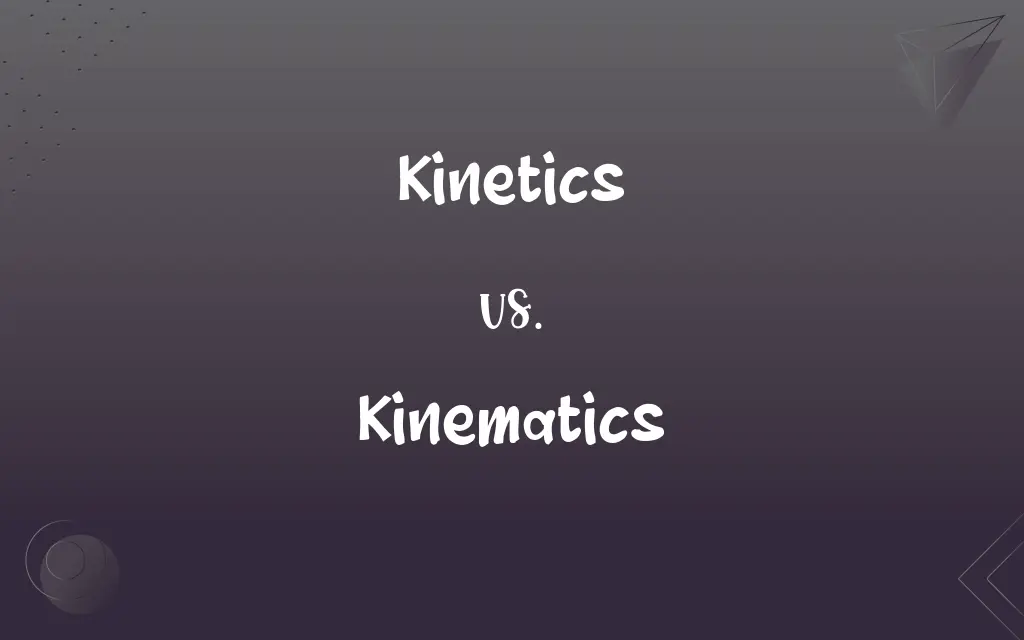Kinetics vs. Kinematics: What's the Difference?
Edited by Aimie Carlson || By Harlon Moss || Updated on October 6, 2023
Kinetics involves the forces that cause motion; kinematics disregards forces and studies motion itself. Both are branches of dynamics in physics that describe motion, yet they approach the subject from different perspectives.

Key Differences
Kinetics is concerned with analyzing the forces and their effects that result in motion. Kinematics, however, involves studying the motion of objects without considering the causes (forces). Both lie under the umbrella of physics, exploring the motion of bodies in distinct ways, yet are integrally connected due to their focus on motion from various angles.
Kinematics delves into aspects such as displacement, velocity, and acceleration, neglecting the forces that cause such motion. Contrarily, kinetics zeroes in on how forces, whether internal or external, influence the movement of bodies. Their theories are utilized in various fields, from engineering to biomechanics, providing insights into the mechanics of movement.
Kinetics finds its applications in scenarios where the cause of motion is crucial, such as when designing engines or exploring chemical reactions. Kinematics is pivotal in fields like animation or robotics, where the path of motion is central, showcasing that while they examine motion, their applicable realms may greatly vary due to their distinct focus points.
Methodologically, kinetics often necessitates a deep, analytical approach to understand the underlying forces and their effects on motion. Kinematics adopts a more descriptive approach, detailing the motion and mapping it out without delving into the causative aspects, thereby differentiating their methodological framework despite the common subject matter of motion.
Even though kinetics and kinematics individually explore different facets of motion, together they offer a comprehensive view. Kinetics explains the “why” behind motion, while kinematics details the “how” of motion. Synchronously, they facilitate a holistic understanding of dynamic systems, highlighting that they are diverse yet interconnected branches of physical study.
ADVERTISEMENT
Comparison Chart
Focus Area
Concerned with the forces causing motion
Focuses on describing motion without considering forces
Methodology
Analytical, exploring the cause-effect relationship
Descriptive, detailing motion’s characteristics without exploring causes
Application Example
Used in understanding how engine parts move due to forces
Utilized in animation to map out character movements without considering forces
Underlying Principles
Involves principles like Newton’s laws of motion
Involves concepts like displacement, velocity, and acceleration
Representation
Often represented through force diagrams and equations
Commonly represented through motion graphs and trajectory paths
ADVERTISEMENT
Kinetics and Kinematics Definitions
Kinetics
Kinetics pertains to the study of forces behind motion.
The kinetics of the car crash were analyzed to understand the impact.
Kinematics
Kinematics explores the geometry of motion without regard to forces.
The kinematics of the robot's arm were studied to enhance its efficiency in movement.
Kinetics
Kinetics explores the relationship between external forces and resultant motion.
In sports biomechanics, kinetics helps understand how different forces influence an athlete’s movement.
Kinematics
Kinematics is a branch of mechanics that describes the motion of points, bodies, and systems of bodies without considering what caused the motion.
Engineers often use kinematics in the design process to predict system behavior.
Kinetics
Kinetics often deals with the cause and effect relationship of forces and motion.
The kinetics of the chemical reaction were studied to optimize the process.
Kinematics
Kinematics investigates the spatial and temporal aspects of motion, such as velocity and acceleration.
In physics, kinematics equations describe the path any object in motion might follow.
Kinetics
Kinetics involves analyzing how various forces influence an object’s movement.
The kinetics of the falling apple were influenced by gravitational force.
Kinematics
Kinematics deals with the motion of objects and groups of objects without considering the factors (forces) that cause the motion.
Kinematics is utilized in biomechanics to analyze the motion of athletes during a game.
Kinetics
In kinetics, the motion is studied with a focus on understanding the forces causing it.
The kinetics of wind turbines are critical to understanding and maximizing their energy output.
Kinematics
Kinematics involves analyzing and describing motion, using terms like displacement, time, velocity, and acceleration.
Kinematics plays a pivotal role in computer animation to simulate natural movements.
Kinetics
See dynamics.
Kinematics
The branch of mechanics that studies the motion of a body or a system of bodies without consideration given to the forces acting on it.
Kinetics
The branch of chemistry that is concerned with the rates of change in the concentration of reactants in a chemical reaction.
Kinematics
(physics) The branch of mechanics concerned with objects in motion, but not with the forces involved.
Kinetics
(mechanics) The branch of mechanics concerned with motion of objects, as well as the reason i.e. the forces acting on such bodies. This, along with kinematics constitute dynamics, which is concerned purely with the effects of forces on moving bodies.
Kinematics
The science which treats of motions considered in themselves, or apart from their causes; the comparison and relation of motions.
FAQs
Are the concepts of velocity and acceleration part of kinematics?
Yes, velocity and acceleration are key concepts studied within kinematics.
What does kinetics involve?
Kinetics involves studying the forces that cause motion and their effects.
Can kinetics be applied to static objects?
No, kinetics specifically pertains to the study of moving objects and the forces acting upon them.
What role does kinetics play in biomechanics?
Kinetics in biomechanics involves studying the forces (like muscle force, gravity) affecting human movement.
Is acceleration studied in kinetics?
Acceleration, while a kinematic quantity, can be involved in kinetics when exploring how forces affect motion.
Is the trajectory of motion a part of kinematic studies?
Yes, the trajectory, or path of motion, is a key element in kinematic studies.
How is kinematics applied in robotics?
Kinematics in robotics helps in understanding and controlling the motion of robots without considering the forces causing the motion.
What is the significance of kinetics in chemistry?
In chemistry, kinetics explores the rates of chemical reactions and the factors affecting them.
Does kinematics involve any concepts related to force?
No, kinematics specifically focuses on motion without considering the forces that cause it.
In what way is kinetics relevant to physical therapy?
Kinetics aids physical therapists in understanding how forces affect joint and body segment movements, enabling effective rehabilitation strategies.
What is kinematics?
Kinematics is the study of motion without considering the forces causing it.
Can kinematics be utilized in animation?
Absolutely, kinematics helps animators create realistic movement by understanding and applying motion principles.
Are distance and displacement concepts within kinematics?
Yes, distance and displacement are fundamental concepts studied in kinematics.
Is velocity a part of kinetics study?
While velocity, a kinematic quantity, can be involved in kinetics studies, it is not an exclusive part of it.
Can kinematics be applied in biomechanics?
Yes, kinematics is used in biomechanics to describe and analyze the motion of biological systems without considering forces.
How is kinetics related to dynamic systems?
Kinetics examines how forces influence the motion in dynamic systems, explaining the cause-effect relationship.
Can kinetics be related to Newton's laws of motion?
Yes, Newton’s laws of motion are foundational to understanding the principles of kinetics.
How do kinetics and kinematics together provide a holistic view of motion?
Kinetics explains why motion occurs due to forces, while kinematics describes how it occurs, offering a comprehensive perspective when combined.
How is kinematics related to speed?
Speed, which is the magnitude of velocity, is a fundamental concept in kinematics as it relates to the description of motion.
Why is kinetics significant in engineering?
Kinetics aids engineers in understanding how forces will impact motion, crucial for designing and optimizing mechanical systems.
About Author
Written by
Harlon MossHarlon is a seasoned quality moderator and accomplished content writer for Difference Wiki. An alumnus of the prestigious University of California, he earned his degree in Computer Science. Leveraging his academic background, Harlon brings a meticulous and informed perspective to his work, ensuring content accuracy and excellence.
Edited by
Aimie CarlsonAimie Carlson, holding a master's degree in English literature, is a fervent English language enthusiast. She lends her writing talents to Difference Wiki, a prominent website that specializes in comparisons, offering readers insightful analyses that both captivate and inform.
































































